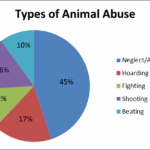Animal cruelty has been a contentious issue throughout history, eliciting both outrage and advocacy. To understand when animal cruelty became illegal in the United States, one must delve into a multifaceted historical landscape that reveals societal attitudes toward animals and the gradual evolution of legislation aimed at curbing their suffering. This journey is not merely a timeline of laws; it reflects deep-rooted cultural values and shifting moral landscapes that inform our current understanding of animal welfare.
The first significant legal action against animal cruelty in the United States can be traced back to the late 19th century. However, the roots of anti-cruelty sentiment can be found even earlier, in the Enlightenment period. Philosophers like Jeremy Bentham posed pivotal questions about the treatment of animals, arguing for their consideration based on the capacity to suffer. This philosophical awakening began laying the groundwork for legislative change.
The Society for the Prevention of Cruelty to Animals (SPCA) was established in 1824 in England, marking the first organized effort to combat animal suffering. The formation of SPCA led to similar movements in the United States, most notably the American Society for the Prevention of Cruelty to Animals (ASPCA), founded in 1866 by Henry Bergh in New York City. Bergh’s efforts were particularly significant; he lobbied for institutionalized protections for animals, thus planting the seeds for future legal statutes.
In its nascent phase, anti-cruelty efforts centered largely on farm animals and the inhumane treatment associated with transportation and slaughter. Bergh’s fervor and the establishment of the ASPCA helped catalyze awareness and prompted local communities to rethink their attitudes toward animals. By the late 1800s, various states enacted their own animal cruelty laws, spurred by communities compelled to protect animals from egregious mistreatment during this industrializing era.
One of the earliest pieces of legislation was New York’s anti-cruelty law passed in 1828, which prohibited cruelty towards domestic animals. Gradually, other states followed suit, establishing similar statutes. These early laws were rudimentary and often varied greatly from one jurisdiction to another, underscoring the absence of a unified national standard. This disparity reflected a broader cultural ambivalence towards animal welfare; while urban centers began to adopt these laws, rural areas remained largely uninformed or unconcerned about animal rights.
The Progressive Era of the early 20th century brought renewed momentum to the animal welfare movement. With the rise of industrial agriculture and the advent of factory farming, calls to reform animal treatment intensified. Public awareness grew, fueled by sensationalist media and grassroots campaigns that highlighted instances of cruelty. Notable events, such as the publication of Upton Sinclair’s “The Jungle” in 1906, depicting appalling conditions in the meatpacking industry, galvanized public opinion and spurred legislative action.
It was during this period that the federal government began to take a more active role. The Animal Welfare Act (AWA) was enacted in 1966 after multiple instances of neglect, abuse, and inhumane treatment came under scrutiny. The AWA set minimum standards for the care and treatment of animals in laboratories, research facilities, and commercial pet breeding. However, while this was a monumental step forward, it notably did not encompass all animals, leaving many species unprotected.
The evolution of anti-cruelty laws continued through the latter decades of the 20th century and into the 21st century. Many states began reevaluating their legal frameworks to cover a broader array of animal species. High-profile cases of animal cruelty and public outcry have pressed lawmakers to consider more comprehensive legislation. Throughout the 1980s and 1990s, laws prohibiting cruelty to farm animals, such as battery cages for hens and gestation crates for pigs, began to gain traction.
In contemporary society, the legal landscape surrounding animal cruelty is increasingly sophisticated, yet challenges remain. Despite a surge in public interest and advocacy, illegal practices continue apace, often operating in the shadows. Ethics surrounding animal ownership, experimentation, and entertainment provoke heated debates. Legislation must balance the rights of animals with complex societal needs, a task that persists as a contentious political issue.
The intermingling of cultural perceptions and legislative action forms a fascinating study into how society values non-human life. This exploration reveals that animal cruelty laws are not merely reactive but are indicative of our evolving moral responsibilities. They point towards a future where animals could be afforded respect and protection, not solely based on their utility but on a recognition of their intrinsic worth as sentient beings.
The journey of animal cruelty legislation has shown considerable progress, yet it is a nuanced narrative filled with victories and setbacks. The historical timeline illustrates that the fight against animal cruelty is ongoing, rooted in a complicated interplay of cultural awareness, ethical consideration, and the demand for legislative change. Understanding where we have been can help us shape where we need to go; as society becomes increasingly attuned to ethical considerations regarding animals, one can only hope that empathy and compassion will continue to guide our actions in the arena of animal welfare.




